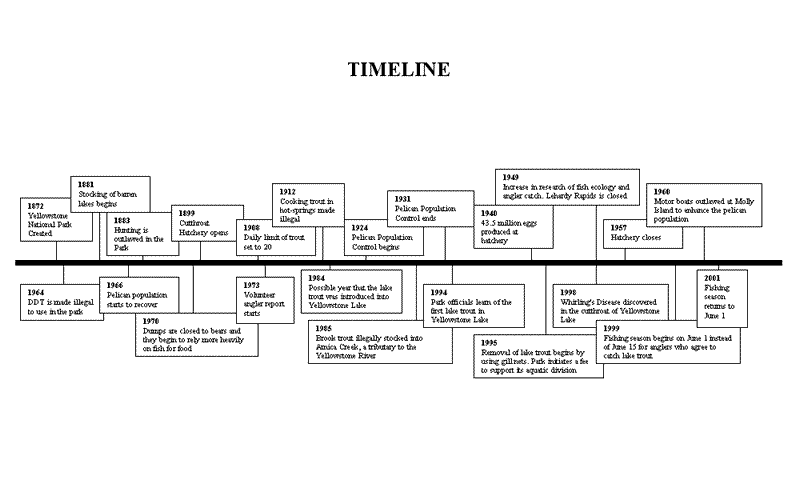|
|
Cutthroat Trout Management | Concepts | Cutthroat Trout Management |
|
DIMENSIONS:
|
History
Yellowstone was established in 1872. The park's fisheries were managed
by the US Fish and Wildlife Service during it's early years. Since
then, policies and social attitudes concerning fish have seen many
changes.
1881 through 1920
Lake hatchery constructed in 1927 as a continuation of the 1899 hatchery. Unfortunately most of those eggs were used in waters outside of the park. Forest fire prevention that started in the 1890's dramatically effected the trout populations as well. Since there were fewer fires, fewer minerals released from fires were washed into the lakes and streams and the capacity for supporting life in the water was reduced.
Starting in the 1920's, in order to attract more
visitors to the park, predators were captured, noisy woodpeckers
were killed near hotels and grandstands were erected around the
dumps to allow the public to view the grizzly
bears fighting for scraps of food. In 1920 a pelican population
control program was started in order to enhance fishing. The white
pelican (Pelecanus eyrthrorhynchos) ate the cutthroat trout
and also carried a parasite that was transferred to the trout.
For these reasons, nests were hunted for and eggs were destroyed.
The campaign against the pelican ended in 1931. The 1920's also
saw a change in angler harvest from sustenance to sport. Due to
the overexploitation of the trout fishery, populations decreased
in Yellowstone Lake and the surrounding areas. In 1949 the park
increased its research on fish ecology and angler catch and today
the park is focused on restoring and preserving native species.
1960's through 1980's In the 1960's park policy changed and allowed
for the recovery of the fisheries to begin. By 1960 it was illegal
to use motor boats at Molly Island
in order to enhance pelican populations. By 1966 the pelican populations
started to recover. With the pelicans on the rise, they were able
to begin reclaiming their place in the ecosystem. DDT was also
outlawed in the park in 1964. In 1970 the dumps were closed to
the bears and the bears began to be more dependent on fish again.
These changes allowed some of the natural predators of the cutthroat
to fill their niche in the Yellowstone ecosystem. However, the
competition between anglers and wildlife for fish was now a problem.
To remedy the problem, the park implemented catch-and-release
policies in certain waters for certain species of fish in the
1980's. Places like Fishing Bridge, that had been closed to fishing
in 1973 became popular places to view fish instead of catch them.
Fish watching gained more popularity when a boardwalk was constructed
and fish viewing signs were posted in 1984 and 1985 respectively.
1984 is believed to be the year that the lake trout were introduced
into Yellowstone Lake.
1990's
through 2001 The first lake trout was discovered in Yellowstone
Lake in 1994 and a $10,000 reward was posted for any information
leading to the capture of the party that was responsible for its
introduction. By 1995 the park had started gillnetting for the
lake trout. To encourage anglers to catch lake trout, the park
opened fishing season on the first of June instead of the fifteenth
of June for those who were willing to fish for lake trout. The
start of the season was changed back to June 15 in 2001. Whirling's
disease (Myxabolus cerebralis) was discovered in the cutthroat
of Yellowstone Lake.
|

